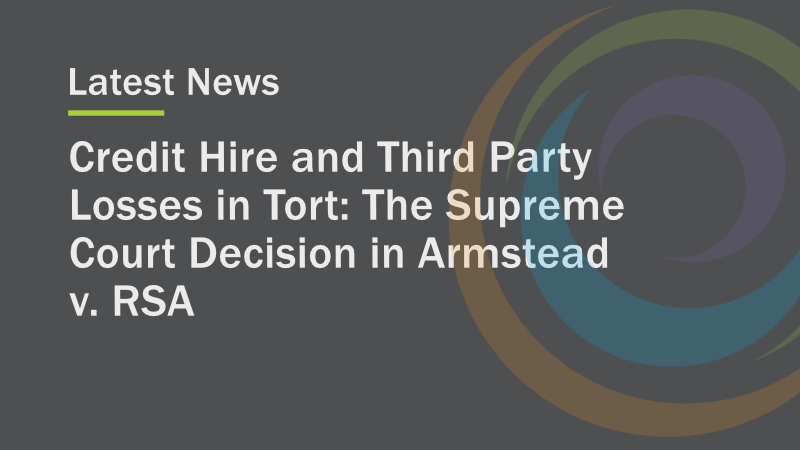Credit Hire and Third Party Losses in Tort: The Supreme Court Decision in Armstead v. RSA
Introduction
It is fair to say that Ms. Lorna Armstead suffered a run of very bad luck; not only was she involved in a car crash that was not her fault and had to hire a replacement car, she was then the innocent party in another collision when driving that replacement. To top it all off, she then ended up in litigation which reached the Supreme Court some eight years later…and all over a debt of £1,560.00!
Background
The debt which formed the subject of the claim arose because of the damage to the hire car that Ms. Armstead was driving when she was involved in the second collision. As is common, the hire company’s terms and conditions obliged her to pay damages for loss of use of the vehicle if it was unavailable due to damage (in essence, Ms. Armstead was contractually obliged to pay any lost hire charges that would otherwise have been earned by the hire company by hiring the vehicle out to a different driver). However, because Ms. Armstead was not at fault for the second collision and the damage which resulted to the hire car, she sought to recover the loss of use costs of £1,560.00 from the tortfeasor’s insurer, Royal and Sun Alliance, in order to extinguish her own liability. RSA refused to pay and the matter proceeded to litigation.
At the first instance small claims final hearing, RSA succeeded. They also successfully opposed the subsequent appeal. They then succeeded again in the Court of Appeal. However, they lost in the Supreme Court and Ms. Armstead’s claim for reimbursement of the loss of use damages was allowed. The decision of the Supreme Court is, therefore, well worth reading in full not least because every other Court which considered the case came to the opposite conclusion. It is also worth reading because the lead judgment includes some thinly veiled exasperation at the apparent failure of the Courts below to apply basic legal principles to the claim; this is perhaps most clearly expressed in paragraph 18 in which Lords Leggatt and Burrows (delivering a joint judgment) state “[t]he claim has been rejected in all three courts below. But numerous different reasons have been given for this result, most of which are, we think, clearly inconsistent with the basic legal principles applicable to claims in the tort of negligence arising out of damage to tangible property.” Oh dear! As a result, the Supreme Court went on to discuss and restate some very helpful principles of general application to all similar claims.
Analysis
Starting from the basics, the Supreme Court set out three “well-established principles” which seemed to have been forgotten in the Courts below. They are:
- “A person owes a duty of care not to cause physical damage to another person’s property (such as a car) and, if in breach of that duty, is liable to pay damages to compensate that person for the diminution in value of the property and any other financial loss consequent on the damage.” (see paragraph 19);
- “By contrast, someone who negligently causes physical damage to another person’s property is not liable to pay compensation to a third party claimant who suffers financial loss as a result of the damage.” (see paragraph 20), and;
- “To count as the claimant’s property for this purpose it is sufficient that the claimant has a right to possession of the property. At common law a person in possession of property has a right to possession of it as against a stranger. Thus, a bailee in possession of property can claim damages from a stranger whose negligence results in the loss of, or physical damage to, the property.” (see paragraph 21).
The Court then went on to add in paragraph 23 that “[w]here it is shown that loss has (factually) been caused by the defendant’s breach of a duty of care, five principles are capable of limiting the damages recoverable by the claimant. They are: (i) the scope of the duty; (ii) remoteness; (iii) intervening cause; (iv) failure to mitigate; and (v) contributory negligence.” It was the first four of those limiting principles which were, at various times, in issue in the case but the Supreme Court found that only the question of remoteness was, in fact, engaged.
The Supreme Court then went on to analyse various elements of the case through the lens of remoteness and made a number of important statements that will, no doubt, be frequently relied upon by lawyers in this field in the future. The most important are as follows:
- A contractual liability is only reasonably foreseeable if the contractual term itself is valid. A tortfeasor can not reasonably foresee terms which are unfair or impose penalties (paragraph 52);
- The loss of use was not a pure economic loss but rather a factual consequence of physical damage to the hire car. Therefore, although it was in a sense a hypothetical loss it was not irrecoverable in principle (paragraph 44);
- A Claimant’s duty to mitigate does not oblige them to embark on satellite litigation where the outcome would be unclear (paragraph 54). This is particularly relevant to hire claims involving disputes about the enforceability of the hire agreement; it seems unlikely that a Claimant presenting a hire claim to a tortfeasor or their insurer would be found to have failed to mitigate their loss by proceeding on the assumption that the contract was valid rather than testing it in separate proceedings;
- The burden of proving any of the five limits to liability (set out above) is generally on the Defendant and not the Claimant (para. 62);
- In determining whether a contractual clause defining compensation for loss of use is a reasonably pre-estimate of loss rather than an unenforceable penalty clause, a “simple and easily calculated sum” is preferable to “a complex and finely-tuned formula” (paragraph 70);
- If the contractual pre-estimate of loss is not reasonable, the Claimant can nonetheless recover a hypothetical reasonable sum (paragraph 72). An analogy can be drawn between this and so-called ‘intervention letters’ where a cheaper vehicle is offered by the tortfeasor to the innocent driver. If the innocent driver refuses the offer unreasonably the Claimant can still recover the cheaper rate rather than have their claim dismissed (see Copley v Lawn [2009] EWCA Civ 580).
In applying all of these principles to the case before it, the Supreme Court held that the only issue of substance was remoteness on the basis that the contractual clause was not a reasonable estimate of the hire company’s loss of revenue while the damaged vehicle was being repaired. However, in rejecting this argument the Court pointedly stated that RSA “did not plead or adduce any evidence” about it (see paragraph 74). Therefore, the appeal succeeded.
Now For Something Completely Different
It is worth noting that Lord Briggs chose to deliver a separate judgment despite agreeing with the majority. The purpose of the judgment was to discuss in more detail the nature of a concession of law made by Ms. Armstead’s Counsel at an earlier stage. That issue need not trouble us but it did mean that there was no argument about the conceded point. This prompted Lord Briggs to state in paragraph 78 that:
“One of the enduring strengths of the common law is that, when it is developed in the appellate courts, the development is subjected to the refiners’ fire of adversarial debate and testing before it is endorsed and, in effect, made into what is sometimes called judge-made law. The epithet “judge-made” is a bit of a misnomer. In reality these step by step developments in the common law are the result, not merely of judicial decision, but also of academic analysis, coupled with the imaginativeness and wisdom of counsel’s submissions.”
One has to wonder whether, given increasing efforts in some corners of the media to portray Supreme Court judges as politically active inventors of unwanted laws, Lord Briggs was attempting to respond and highlight how judicial decisions come to be made. Judges are, of course, prohibited from publicly commenting on their cases but that does not prevent a little bit of push back in an appropriate forum!
Michael Trevelyan
Barrister, Cornwall Street

